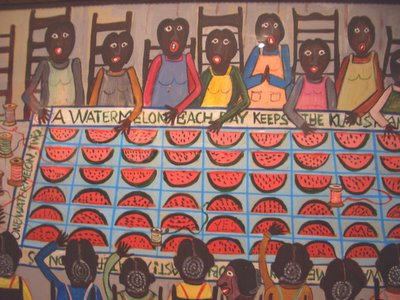
Just one week left to see this painting (poster paint, even) at The Kansas City Museum before it returns to the private home of its owner, Scott Heffley (painting conservator for the Nelson-Atkins).
Tomorrow, you can even see him live, when he returns to the Beaux Arts maison everyone loves to lament, to close "Bold Improvisations: 120 Years of African-American Quilts." He was at the opening back at the end of January, but I didn't go and only ran into him by accident one afternoon. He had come back to see the show in a quieter setting.
The talk tomorrow, according to P.R., is about the process of collecting and the significance of the quilts. The exhibit is up through April 2.
If you come (at 2 p.m., 3218 Gladstone Blvd., Historic Northeast, not Gladstone, Mo.), to hear the lecture, you will notice as I did that he is white.
Well what were we expecting?
I had been trying not to expect anything at all.
I left that question open and unanswered until that visual moment, but when you're trying not to think about something, you can't not think about it. So, did I expect, for some reason, that a collector of historically-significant and visually-striking home-assembled bed-coverings might be of the same culture as they?
Let's enjoy some fruit together first:
The painting above, Watermelon Quilt is by Sallielou P. Eakins (Reading, Penn., 1988), a so-called "outsider artist" who says she first finds a frame and then begins to paint something to fill it. The guys from "Rare Visions and Roadside Revelations," whom I've often wanted to strangle for their condescension and classism, would have a hey-day with her process, I'm sure. She's so outside, though, that I could only find information about two other Eakins artists, Susan and Thomas.
So, bring whatever race you happen to be in your head to view this parody of the famous stereotype and see how it makes you feel when you read:
A WATERMELON A DAY KEEPS THE KLANSMAN AWAY.
It might make you laugh. I mean, just look at the quilters' expressions.
The other items in the exhibit, which, to be honest, I only went to see because I was supposed to, are not as emotionally-charged, at least not on the surface. You would have had to have talked with these women, who sewed in the 1930s, the 60s and 70s, and even the early 1900s, to get close to finding out what was going on in their lives. A few of them are contemporary, working consciously as textile artists, like Sarah Mary Taylor (as seen in "The Color Purple" film), but she died in 2000, too.
Most traces of family history had vanished by the time Heffley got the quilts.
Obligations aside, I returned to the exhibit because it is quite beautiful. I know, who would think that quilts can be interesting, but these are on a number of levels.
There's the patterning, the structure, the technique - all junk I know nothing about, since, who quilts anymore, right? - that at any rate, form a piece of female heritage. I'm female, so this is something I can relate to. It's good as a human to have some textile skills, anyway, since you never know when the shit is going to go down and you'll be stuck turning draperies into dresses like Scarlet O'Hara. . . .
There's remarkable contrast between these quilts and the prim (and even dull) standard examples from white culture, represented by some photographs and good descriptions. Hence the "bold improvisations" thing. . . .
There's good background hinting, represented by some other photos and actual pieces of African-made cloths from a number of different regions, that show how pattern preferences, the use of certain symbols, color, etc. have been passed down and transformed as only Americans can transform old world culture.
There's sheer wonderful artistry, arrangements of color that predate Abstract painting, attention to movement and detail, in short, a heck of a lot going on visually to keep the eyes working for a good while.
Then, there's the undercurrent of the distance between the lives of the quilters and people like me or Scott Heffley. One of the quilts, a shaded spinning star made of hundreds of individual triangles, is bordered by cloth that still bears commercial print announcing the "cured and salted bellies" inside. Another one, "found" in Kansas City, Mo. and sold to Heffley by just one go-between, is only 30 or 40 years old, but disconnected from its family. The description card reads, "The African-American dealer who sold this quilt knew the location of the house where he bought it in Kansas City, but unfortunately not the family's name."

2 comments:
interesting. who quilts anymore? actually my sister-in-law and some of her friends. http://www.threadconnection.com/blog_new
What a moving painting, t. Quilting culture and marginalization has been on the brain here in Auburn this year thanks to the Gee's Bend quilts which were at our art museum for the fall - we had lots of lectures about slave quilts, African textiles, US textile history, African mythology represented in slave quilts, etc. I just noticed there's to be a stamp series of the Gee's Bend quilts later this year (assuming the little poster at the PO is to be trusted). This painting reminded me of one of our speakers in particular (doh! I of course can't find her name) who had several slides of quilts whose imagery seemed very similar to this imho. The Quilts of Gee's Bend are in fact completely different than any of that imagery was but they are quite striking if you want to see: http://www.quiltsofgeesbend.com/
:)
Post a Comment